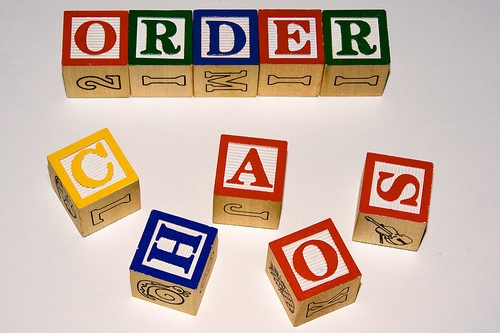Running a small business can be chaotic.
The definition of “chaos” is “complete disorder or confusion”. Does that sound like your business?
Some synonyms of “chaos” are: disorder, disarray, disorganization, confusion, turmoil, commotion and disruption.
Are You Operating In Constant Chaos?
If you’re honest, you and your employees have probably felt these feelings over the past several months. These type of feelings are not great and no organization can stand operating in chaos very long. It takes a huge toll on people.
Maybe you’re not in complete disorder, but could you describe your business as having complete order or clarity? What would your employees say if asked that question?
I began my career as a scientist so I tend to think about the parallels with science and business. In science, there is a concept called “entropy“. In very simple terms, entropy refers to the idea that everything in the universe eventually moves from order to disorder. You don’t have to do anything to create disorder. It just happens.
This idea is also true for your business. Your business will tend towards disorder or chaos. That chaotic and “out of control” feeling you feel is the natural order of things. You need to fight against it. You need to “put energy into the system” to make it more ordered. Your business is not going to spontaneously become ordered. Much like the dishes don’t spontaneously get cleaned or your office desk get organized, you must put energy in to clear the dishes and clean your desk.
What does this have to do with your business? If you think your business will be more ordered and less chaotic spontaneously, it just won’t happen. Focusing on your endless task list is not the solution. You need to deliberately put energy in (yes even extra energy) to bring order. It may be the case that the energy you are putting in is actually increasing the chaos.
So HOW do you reduce the chaos and create more order? Here are 5 simple steps:
Define Your Company’s Vision
This is going to require some work. Some mental energy will need to be expended to define and clarify where you are leading the business in concrete terms.
What are your core values?
What is your mission or “why”?
What is your BHAG (big hair audacious goal)?
Once you’ve done this work, you need to communicate this to your staff.
Define 3-5 Company Goals That Must Be Accomplished In The Next 12 Months
This is where the “boots meet the ground”.
What specifically are you going to focus on over the next 12 months that will get you closer to realizing your vision? If you’re not clear on your vision, see point #1.
You may want to get your team involved here to make sure you’re focusing on the right things.
Define How You Will MEASURE Accomplishment Of The Company Goals
Creating goals is not enough. You need to determine HOW you will measure whether or not you achieved that goal.
Some call this metrics or KPIs (key performance indicators).
If your goal is to achieve $5M in revenue in 2016, you will want to measure your revenue monthly to determine if you are on track.
Make it simple to begin. One KPI per goal.
Define WHO Is Responsible For Each Company Goal
Who is ultimately responsible for each goal?
If no one is responsible, your chances of success will drop dramatically. This is one of the main reasons why chaos exists in organizations. No one knows who’s responsible for what.
Balls get dropped. Confusion and frustration ensues.
Check In Monthly To Determine If You Are Making Progress, If Not Adjust
This is probably the most critical point and the one area where most organizations fall down.
If you never check your progress, how will ever know if you are achieving what you set out to achieve? All the hard work done in points 1-4 is lost.
If you, as the owner, is the only one looking at the results, you will carry all the pressure and the stress (maybe that is the source of much of your chaotic feelings).
Invite your team to review the results. Invite them in to experience the pressure. The best team members want to step up to the plate and make it happen.
I often help businesses create budgets and operational plans. For one particular company in the first year of our engagement, the CEO and I built the budget and plan. We then shared it with the team. We took this approach because there was not a lot of time to get the budget completed before year’s end. In spite of this the company grew over 50%, but there was not 100% buy-in from the team. The team was not intimately involved in building the plan. Much time was wasted due to confusion. Could they have grown at 100%?
This year, we did something different. We invited the team to be involved from the beginning. The team validate the assumptions around sales. Next, we determed how many people we would need to deliver on those sales. Did we have the right operations expenses? We literally built the plan TOGETHER. The result, a much more engaged and involved team.
So, if you want to stop the chaos, you need to put some energy in to create the order your organization craves.
Want to cut through the chaos? Don’t know where to start? Here are some next steps:
- Download the FREE company goal setting guide here
- Sign up to attend a FREE demo of Envisionable – our business alignment platform and start keeping score!
